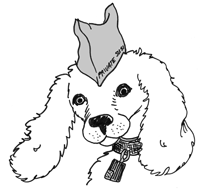STRANGE BUT TRUE- Dogged help: How Spot helped win the war

DRAWING BY DEBORAH DERR McCLINTOCK
Q. They were commonly sentries, also scouts, pack carriers, gun and ammunition haulers, artillery or gun spotters, layers of telephone wires, even reducers of rat populations in army camps or fox holes or trenches. Who were these dogged contributors to the World War II cause?–R. TinTin
A. Dogs, says Canadian psychologist Stanley Coren in What Do Dogs Know? In the U.S. alone, well over 50,000 of them were enlisted and ended up at one of five War-Dog Reception and Training Centers. In addition to the above, many canines were trained for delicate and dangerous tasks such as mine detection. Their especial importance lay in finding non-metallic plastic mines in North Africa, since these devices were completely invisible to traditional magnetic mine detectors.
Perhaps their most exotic occupations were as spies or infiltrators into enemy camps to steal documents. Before it was all over, "almost all breeds of dogs had been drafted by the U.S. Army."
Q. Let's talk trashy lingo for a minute: What has the dubious honor of being the fastest growing segment of the garbage system?–S. Jobs
A. Six billion humans generate an awful lot of "e- waste," or "e-scrap," in the form of discarded computers, monitors, cellphones and other electrical gewgaws, says Paul McFedries in IEEE Spectrum magazine, with the process of recycling these components called "e-cycling."
The sheer quantity of all this electrical and electronic equipment is bad enough, but then there are its toxic heavy metals, such as lead, cadmium, mercury. That's why many municipalities mandate that old electronics must be e-cycled (such as a British law forbidding the tossing out of erotic e-toys).
When such recycling takes used or recycled materials and creates a new product with a higher value, that's "upcycling" (as opposed to traditional "downcycling"). The hidden riches therein are "green gold," and companies staking a claim on it are "urban miners" doing "aboveground mining."
Hip consumers are starting to "precycle," or choose gadgets based on recyclability. Some manufacturers now follow their products cradle to cradle, even sponsoring free take-back programs for end-of-life devices.
"Of course, you could also follow the lead of a nut-orchard owner in Australia, who wanted to attract birds to eat pests. His solution? Convert the shells of old Macintosh computers into birdhouses!"
Q. What is it about big-city folks that makes a metropolis such an oasis of creativity and invention?–L. Doolittle
A. It's the mathematics of burgeoning relationships that does it. Imagine the twosomes in just a family of five, or a, b, c, d and e. They pair up as a-b, a-c, a-d, a-e, b-c, b-d, b-e, c-d, c-e, d-e. That's 10 twosomes, or (5 x 4) divided by 2. Now step this up to a megalopolis and the numbers explode.
That's the magic of networking, says New Scientist magazine. When you double the size of a city, you more than double the number of potential relationships and interactions that can occur, resulting in surging numbers of inventions and patents, reports Samuel Arbesman of Cornell University. It's the sheer size of cities that generates so many more connections between people of very different personalities and complementary skills, fostering "melting pots of innovation." Eureka!
Q. Resident of one of Earth's chillier locales, you invite your new fiancee from down South to join you in your igloo for the winter holidays. "But it's freezing there," she protests. "But we'll be inside," you correct. Is there anything you can tell her scientific mind to put her more at ease?–D. Zhivago
A. In spite of its dome-shaped structure, the snow- and ice-block igloo can keep you pretty warm regardless of the weather, says Jearl Walker in The Flying Circus of Physics. Not only will you be shielded from the wind, but the walls provide thermal insulation, meaning that any heat energy radiated from your body will stay inside.
A well-made igloo is squat with an elevated "sleeping bench" across much of the interior floor, so warmer (lighter) air inside will rise and collect there, the reason why igloos are built without very high peaks. Other thermal safeguards: The thicker walls or walls with loosely packed snow (having plenty of air pockets) decrease conduction and so maintain interior warmth. Also the spaces between the blocks are sealed with hard-packed snow, both outside and inside, that tends to melt and then refreeze into a protective ice layer. "Now, my love, I trust you are feeling warmer already."
~
Send strange questions to brothers Bill and Rich at [email protected].
#